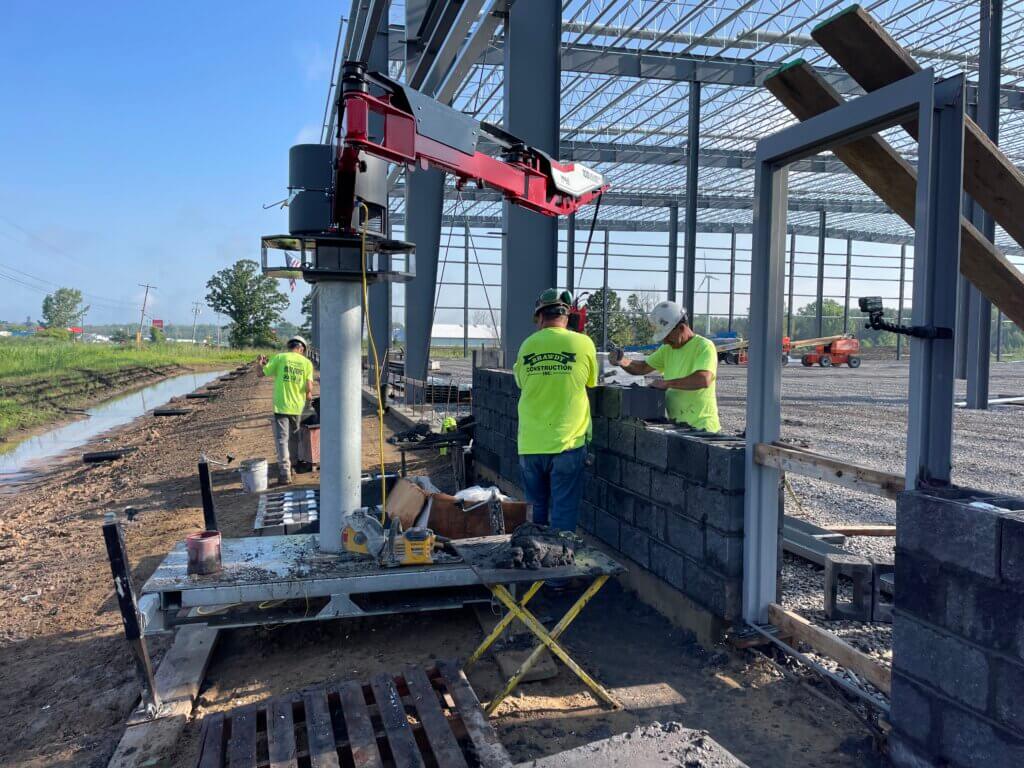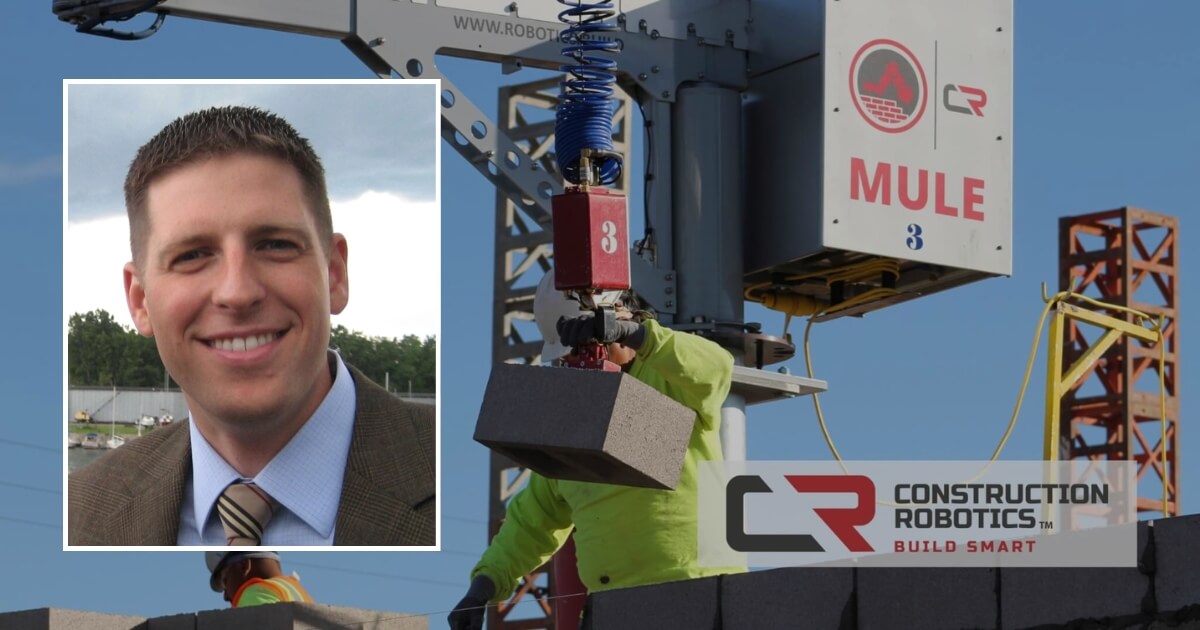Scott Peters, co-founder and President of Construction Robotics, is not your typical tech disruptor. He didn’t come from Silicon Valley, but from the world of high-volume manufacturing, where precision and productivity go hand in hand. Today, he’s applying that same logic to construction sites across North America through his company’s pioneering technologies, including SAM (the Semi-Automated Mason) and Construction Robotics MULE (Material Unit Lift Enhancer). These robotic innovations are making hard labor easier, extending careers, and opening doors for new talent to enter the trades. From heavy lifting to high-tech planning, Peters is building a smarter and faster way to build.
This article is a summary of the main topics covered in our interview. It has been edited for clarity and conciseness. If you want to watch the entire episode discussing the latest developments in construction robotics, you can find it on our YouTube channel here: https://youtu.be/f9cHKj_ZBYs
UTHH: For those who don’t know, what is Construction Robotics all about?
Scott Peters: We’ve been focused from day one on introducing smart, assistive technology to the job site. Our main goal is to improve the way construction work gets done by reducing physical strain and increasing productivity. Our flagship product is the MULE, which stands for Material Unit Lift Enhancer. It’s a smart-lifting device that makes heavy materials feel weightless, allowing crews to move blocks or other materials safely and efficiently without wearing themselves down.
Today, we’re primarily working in masonry, but that’s quickly changing. We’re starting to expand into other trades and sectors because the core technology is versatile. If something needs to be lifted or moved with care and precision, we can probably help with that.
UTHH: What made you target masonry first? Was there a lightbulb moment?
SP: The idea really started taking shape around 2007 or 2008. My co-founder, Nate Podkaminer, was a veteran in the construction industry. He spent decades building projects in Central New York and saw the toll that repetitive, heavy labor took on workers. I came from the manufacturing world, working with companies like Intel and General Motors, where automation and robotics were already being used to solve those kinds of problems.
We asked, “Why can’t construction sites benefit from this kind of technology too?” Initially, we focused on robotics for bricklaying, which led to the development of SAM, which stands for “Semi-Automated Mason.” It was a true robotic solution that laid bricks and worked alongside masons. SAM taught us a lot about how technology integrates with real job sites, which are far more dynamic than a factory floor. Every day on site brings new materials, new conditions, and new challenges.
That learning process eventually led us to the MULE. It’s simpler, more adaptable, and works with crews in a much more seamless way. We realized that while full automation might be possible in the future, what the trades really needed right now was help; something assistive, intuitive, and ready to deploy.
Want to see the MULE in action? Check out the demonstration video below.
Video courtesy of Construction Robotics.
UTHH: Do you remember the first time you saw the Construction Robotics MULE in action?
SP: Absolutely. We were on one of our first job sites with a prototype version. It wasn’t pretty, it was a little rough, a little loud, but it worked. One of the masons testing it out had been laying block for over thirty years. You could tell his body had taken a beating from the work. After a couple of hours using the MULE, he came up to us and said, “Where was this 30 years ago? I feel like I’m laying block like I’m 20 again.” That moment stuck with me. It confirmed we were solving a real problem in a meaningful way.
UTHH: Construction, and masonry especially, is very tradition-driven. Was it difficult convincing veteran crews to embrace robotics?
SP: For sure. Change is always hard, and construction is an industry that tends to hold onto what works. Masonry, in particular, is a generational trade. People learn the craft from a parent or mentor, and there’s pride in doing things by hand. So yes, there was skepticism at first.
But what we found is that once people see the MULE in action and actually try it, the resistance starts to melt away. A lot of the older masons, especially those who have had shoulder or back injuries, immediately recognize the benefit. It doesn’t replace them. It just helps them keep doing the job they love, for longer and with less pain.
Here is a video of Construction Robotics MULE on site to demonstrate how it assists workers.
Video courtesy of Construction Robotics.
UTHH: The skilled labor shortage keeps making headlines. Do you think robotics will be a lifeline for the industry, or just a competitive advantage?
Peters: I think it’s already both. A few years ago, using robotics was considered bleeding edge. Today, we’ve got contractors telling us they need the MULE just to stay operational. Their teams are aging. They’re having a hard time attracting young people. They’re struggling to reduce injuries and maintain productivity. In that environment, robotics is not a luxury, it’s a necessity.
The nice thing is, these tools don’t require anyone to reinvent the wheel. We’re not replacing masons with robots. We’re giving them superpowers.
UTHH: What do you say to people who worry that robots are going to steal jobs?
SP: That’s a common fear, but I think it’s missing the bigger picture. Job sites are evolving, just like every other workplace has. Look at farming or manufacturing. They don’t look anything like they did 100 years ago, but the work didn’t disappear, it just changed. The same thing is happening in construction.
Technology allows us to rethink who can do the work. You don’t have to be a bodybuilder to be a mason anymore. We could see more women, more diversity, and a broader range of workers coming into the trades. That’s a good thing. It expands the talent pool, makes the industry more inclusive, and ultimately, more resilient.
UTHH: Looking ahead, what does a high-tech job site look like in 10 years?
SP: It starts with planning. We’ll use AI and smart modeling to plan everything out in advance. That gives us more accurate schedules, fewer surprises, and better coordination from day one. On the ground, I think we’ll see a mix of autonomous equipment and assistive technology. Think robotic handlers, automated telehandlers, and smart cranes that adjust in real-time.
But it won’t be a job site run by robots. It’ll be a job site run by people using machines that make their work easier, faster, and safer. And the data generated from all of that, productivity, disruption alerts, equipment performance, will help project managers make smarter decisions and adapt faster. That’s the future I see.

The MULE MZ100 in action. Photo courtesy of Construction Robotics. To find out more about the MZ100, check out their website here.
UTHH: It sounds like you live and breathe innovation. How do you unplug?
SP: I’ve got three kids, ages 15, 12, and 10, so they keep me on my toes. We spend a lot of time outdoors. In the winter we’re skiing. In the summer, it’s sailing or wakeboarding. I also love tinkering. I’m always experimenting with new ideas or building something just for fun. I guess that’s the inventor in me. Even when I’m not working, I’m usually still creating in some way.
UTHH: Would you say that tinkering instinct is what brought you to this career path?
SP: No question. I’ve always been drawn to solving problems. When Nate first approached me with the idea, it was clear there was a real challenge, and I couldn’t resist trying to figure it out. That’s just how I’m wired. I’ve launched other products and businesses, but Construction Robotics has had the most impact. And that’s what keeps me going.
UTHH: What’s next for Construction Robotics? Where are you headed?
SP: We’re moving beyond masonry. Smart lifting applies across the board. We’ve already started working in solar, lifting and installing solar panels more safely and efficiently. We’re testing applications in glass handling, retaining wall blocks, and even equipment that could eventually lift up to 1,000 pounds weightlessly.
We’re also refining the tech to include small autonomous movements, little things that make a big difference. For example, when the MULE sets a block down, it can sense when the weight is off and automatically back away without splashing the mortar. That kind of fine-tuned automation helps make work smoother and more consistent, without requiring the worker to do anything extra.
We’re actively looking for partners and collaborators in different trades who want to explore new applications. That kind of pull from the field is what drives real innovation.
UTHH: You’re saving bodies, timelines, and probably a few careers along the way. Thanks so much for sharing your time with us.
SP: Thank you. It’s been a pleasure.
If you’ve enjoyed this conversation with Scott Peters and Construction Robotics, we’ve got more interviews coming your way. Subscribe to the Under The Hard Hat Newsletter to get them delivered straight to your inbox so you don’t miss a beat!


